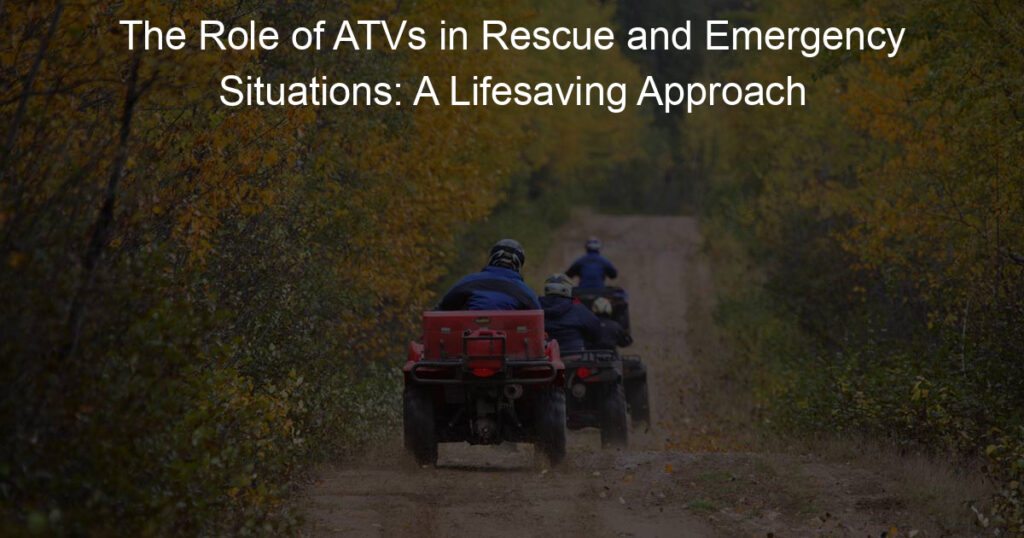All-terrain vehicles (ATVs) and utility terrain vehicles (UTVs) are increasingly being utilized in rescue and emergency situations, providing vital support to first responders and law enforcement agencies.
These off-road vehicles boast capabilities to traverse difficult terrains and reach remote areas, making them a crucial asset in time-sensitive operations.
In recent years, the role of ATVs in rescue and emergency situations, including firefighting and flood response efforts, search and rescue missions, and medical evacuations.

Their exceptional mobility enables them to access hard-to-reach locations, while their versatility allows for the mounting of essential equipment and tools.
Key Takeaways
- ATVs and UTVs are important assets in rescue and emergency situations.
- These vehicles can traverse difficult terrains and be equipped with the necessary tools.
- Their usage extends to firefighting, search and rescue, medical services, and more.
Understanding ATVs and UTVs
As an ATV enthusiast, I find it important to understand the role of All-Terrain Vehicles (ATVs) and Utility Terrain Vehicles (UTVs) in rescue and emergency situations. ATVs and UTVs are versatile machines built to handle a range of terrain types – from muddy trails to rocky slopes.
They serve as invaluable tools for emergency responders and rescue crews across the globe.
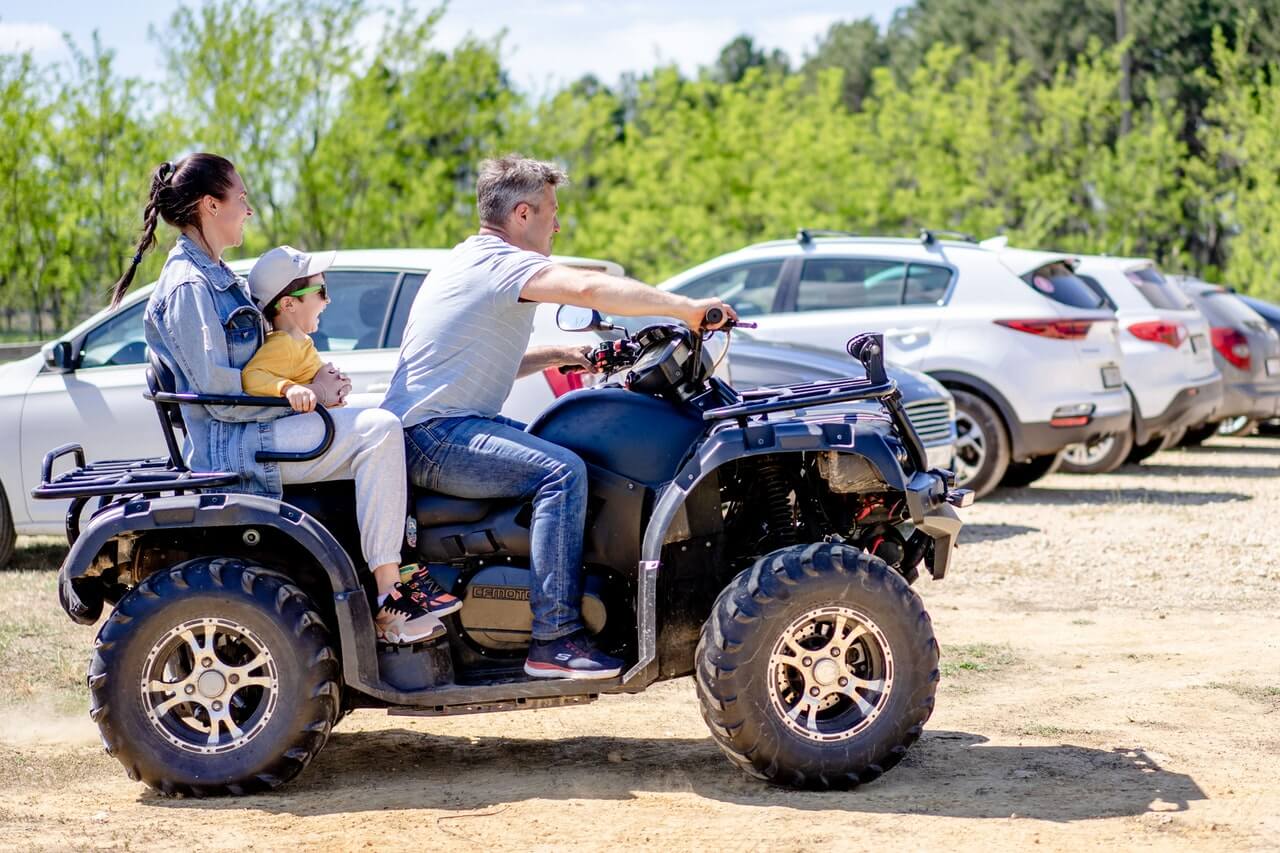
ATVs, also known as quads or quad bikes, are smaller, lightweight machines designed for single riders. They possess four wheels, low-pressure tires, and a straddle-seating style that allows the rider to maintain stability while navigating diverse landscapes.
Given their maneuverability and ease of use, ATVs are ideal for traversing narrow trails or dense forested areas, reaching points that larger vehicles may not be able to access.
On the other hand, UTVs (Utility Terrain Vehicles), also known as side-by-sides, are built to be functional workhorses. These vehicles are larger than ATVs, boasting a side-by-side seating arrangement, and are capable of accommodating multiple passengers.
UTVs possess a steering wheel, foot pedals, and a cargo bed for transporting equipment. Their sturdier build allows them to haul heavier loads, tow trailers, and handle more complex situations. UTVs have found their way into the hands of emergency responders due to their utility and adaptability.
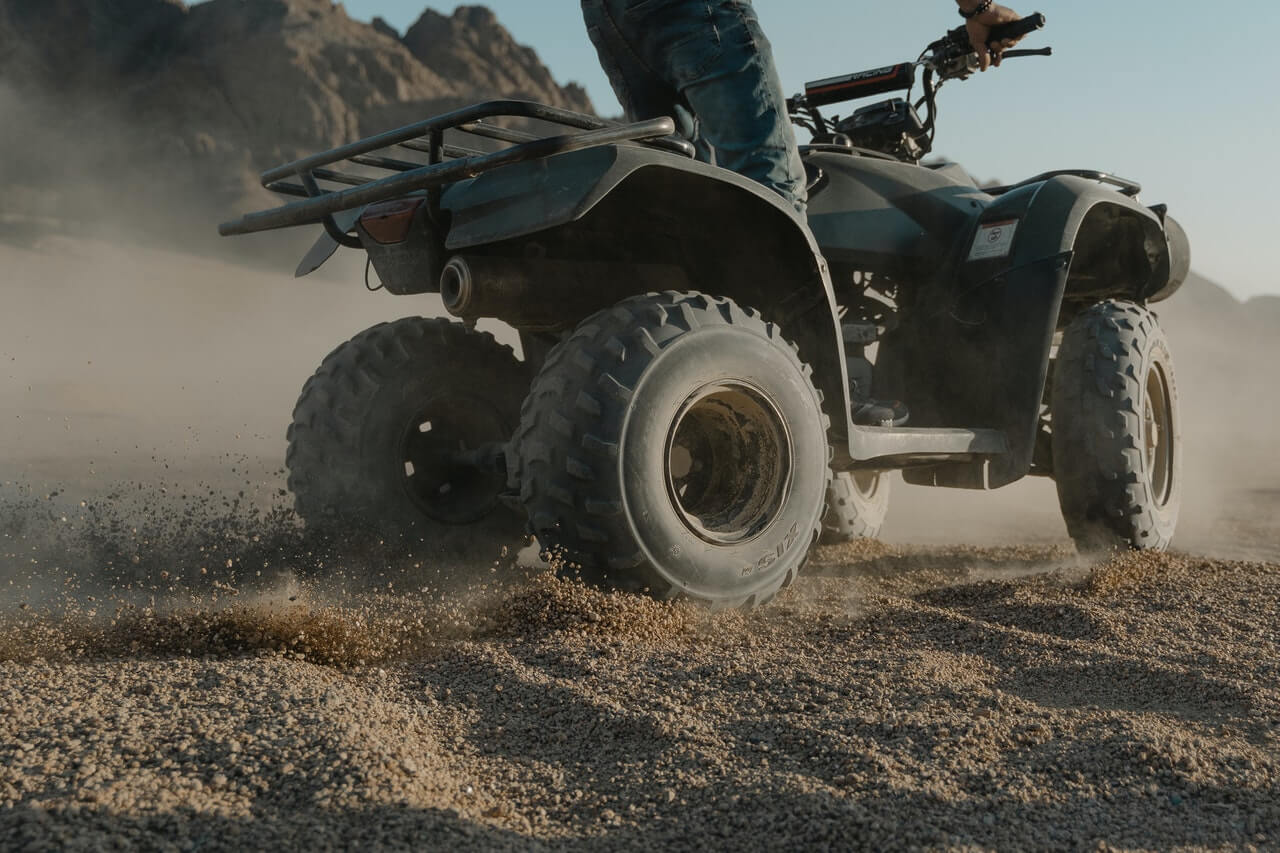
Polaris, a leading manufacturer of off-road vehicles, offers a range of ATVs and UTVs specifically designed for emergency response situations. Their specialized vehicles come equipped with features such as firefighting equipment, medical stretchers, and winches to aid in rescue efforts.
The additional capabilities of these purpose-built machines showcase the importance of ATVs and UTVs in emergency scenarios.
Both ATVs and UTVs have essential roles in rescuing and responding to emergencies. Their inherent versatility, maneuverability, and functionality make them indispensable tools for first responders, firefighters, and search and rescue teams alike.
The Role of ATVs in Rescue and Emergency Situations
Transport in Diverse Terrains
As a rescue worker, I appreciate the versatility of ATVs in various terrains. From urban environments and rural landscapes to beach and trail settings, ATVs can easily navigate these areas for emergency response.
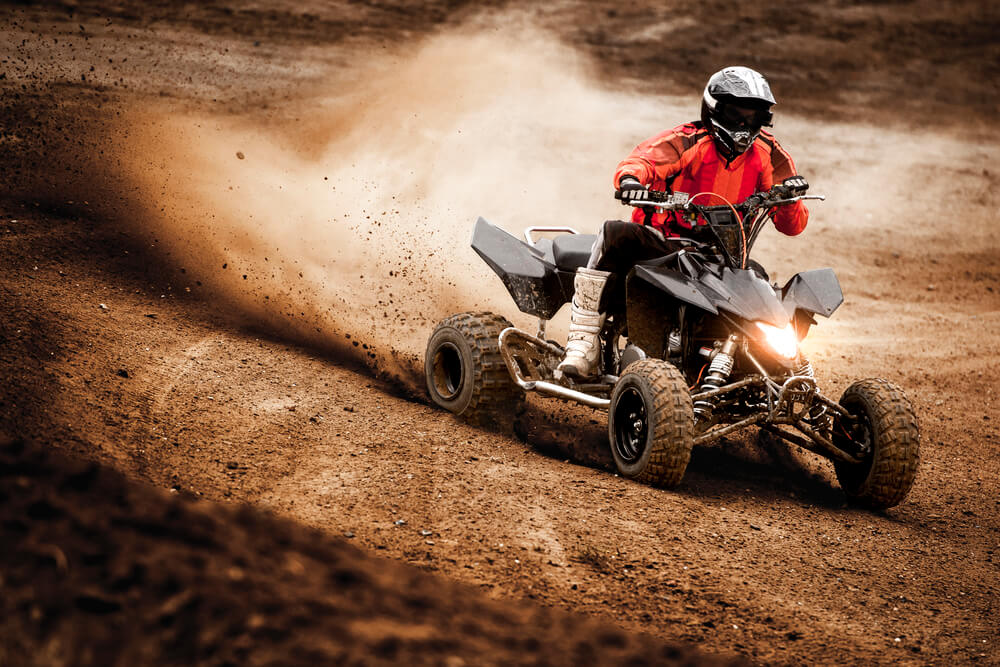
The ability to quickly transport critical supplies and personnel goes a long way in facilitating successful rescues.
In urban settings, ATVs can easily maneuver through congested traffic, while in rural environments, benefit from the vehicles’ ability to traverse uneven and rugged terrain.
Similarly, beaches and trail systems can be challenging for traditional emergency vehicles, but ATVs can easily navigate them, allowing for a more efficient response.

Payload and Carrying Capacity
The payload and carrying capacity of ATVs is another factor that makes them valuable in rescue situations. They have the ability to carry substantial equipment, with some models boasting payload capacities of up to 1,000 pounds.
This is crucial when transporting injured individuals or heavy gear during emergency situations.
Furthermore, ATVs can be equipped with attachments like cargo baskets, winches, and stretcher mounts, which allow them to carry additional equipment or transport people in need of medical attention more effectively.
Safety and Stability Features
Safety and stability are paramount in rescue and emergency response situations.
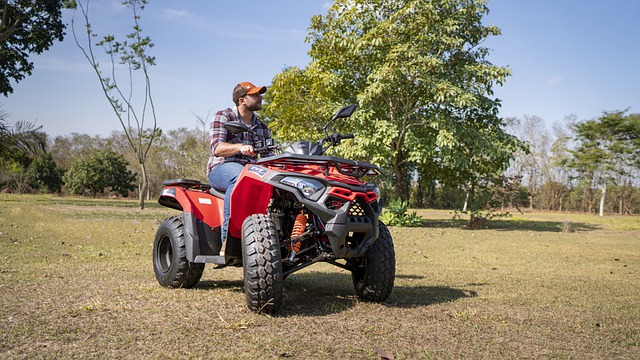
ATVs possess several features that enhance their safety and stability, such as:
- Wheels and suspension: ATVs have advanced suspension systems, which provide a smooth and stable ride. This is essential for traversing uneven terrain and rough trails.
- Lights: Most ATVs come with powerful lighting systems, ensuring proper visibility during nighttime operations or low-light conditions.
- Roll bars: For added safety, many ATVs are equipped with roll bars that protect the occupants in case of an accident. This is especially important when operating in challenging environments.
- Skid plates: These protective devices shield the vehicle’s underbelly from rocks, debris, and other hazards that could potentially cause damage during a rescue operation.
In my experience, the aforementioned features contribute significantly to ATVs’ effectiveness in emergency and rescue situations. By ensuring stability and safety, they enable rescue workers to concentrate on their primary mission: saving lives.
Specific Utility in Fire and Rescue Services
Firefighting Applications
From a first-person singular perspective, I’ve noticed that ATVs are of great value to fire departments when it comes to fighting fires, especially in areas with tough terrain and limited access to large fire apparatus.

With their ability to navigate through narrow trails and transport fire suppression equipment, they have become an essential tool for many wildland firefighting units.
In addition to their mobility, ATVs can be equipped with hose reels, water tanks, and pumps to provide quick-response fire suppression.
For instance, the RKO skid unit is designed specifically for ATVs to carry firefighting equipment, transforming them into formidable firefighting machines

. In this way, fire departments can rapidly respond to fires, preventing them from spreading and causing further damage.
Patient Transport and Rescue Operations
When it comes to patient transportation and rescue operations, ATVs are a game changer. Conventional rescue vehicles may struggle to access remote or difficult-to-reach areas, whereas ATVs boast superior maneuverability.
Many fire departments are now utilizing ATVs equipped with the 85EMS and the 85EMS-C systems, which allow patient transport on a longboard or Stokes basket, respectively.
Not only are ATVs able to reach patients faster, but they also ensure more comfortable and stable transportation. The use of specialized equipment, like winches and retractable utility poles, further assists in the safe and efficient extraction of patients from challenging rescue scenarios.
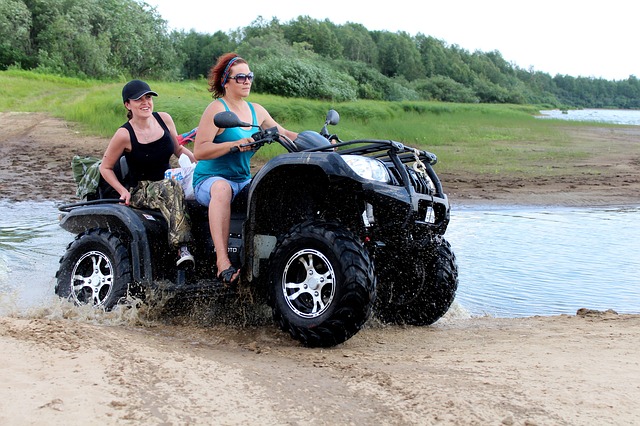
Usage in Search and Rescue Missions
In search and rescue (SAR) missions, time is of the essence. As a friendly advisor, I found that ATVs are invaluable tools for fire departments in these critical situations. Their flexibility allows them to quickly traverse various terrains, ranging from wooded areas to sand dunes, thereby expediting search efforts.
SAR teams can choose from various ATV attachments to enhance their search capabilities. For example, they can mount communications equipment, such as radios and antennas, as well as navigational tools, like GPS devices and map holders.
To ensure the safety of rescuers, ATVs can be outfitted with helmets, goggles, and other personal protective gear.

In summary, the multifaceted utility of ATVs in fire and rescue services has made them indispensable assets. Their adaptability to diverse terrains and customizable features make them truly valuable resources in firefighting, patient transportation, and search and rescue missions.
Equipment and Tools Employed
When I’m using ATVs in rescue and emergency situations, one of the essential parts of the operation is the equipment and tools employed. In order to perform my duties effectively and safely, I need to be well-equipped with the right gear.
Personal Protective Equipment (PPE) is a must in such scenarios. To protect my hands, I always wear gloves made of sturdy and cut-resistant materials. Safety is a top priority, and I make sure to wear appropriate gear like helmets, goggles, and proper footwear.
An important apparatus I employ during rescues is a versatile and sturdy trailer. These trailers are specially designed to handle the challenging terrains that ATVs can access and are used to transport essential equipment, tools, and even patients or victims.
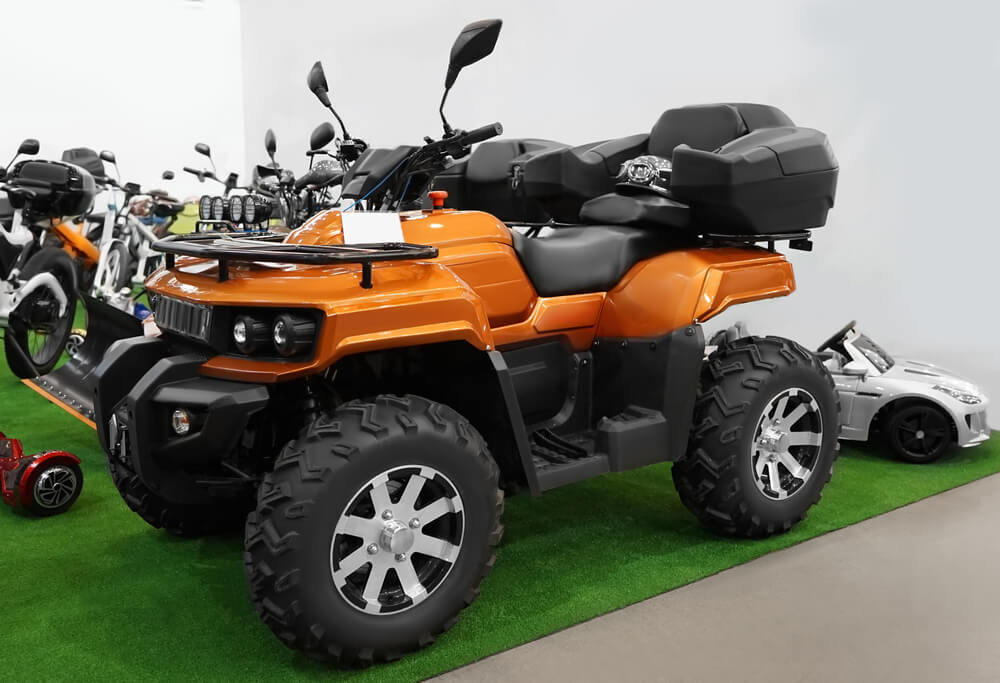
Debris removal tools like chainsaws, winches, and ropes are crucial to clear paths and gain access to hard-to-reach areas. These tools are vital to rescue operations and can often make the difference between success and failure.
As the incident commander, it’s my responsibility to ensure that the medical equipment and supplies are on hand for both victims and rescue personnel. Medical bags, portable first aid kits, and an oxygen bottle holder are indispensable when responding to rescue scenarios.
The equipment and tools employed during ATV rescues play an essential role in ensuring the safety and success of the operation. My experiences have taught me that being well-equipped and prepared is key when trying to help others in challenging and sometimes dangerous situations.
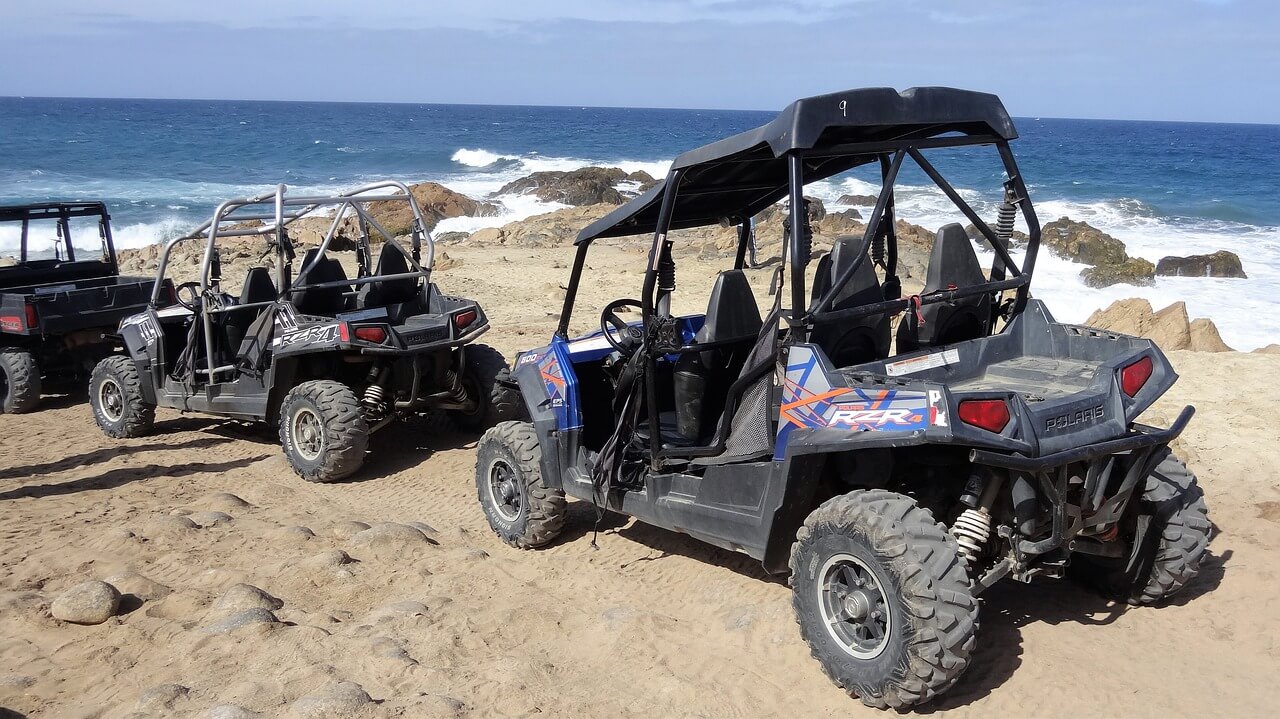
ATVs and UTVs in Emergency Medical Services
Role in EMS
As a member of emergency medical services, I’ve noticed the significant impact ATVs (All-Terrain Vehicles) and UTVs (Utility Terrain Vehicles) have on our ability to provide effective care.
These vehicles enable us to reach patients more quickly and efficiently, particularly in challenging environments where other emergency response vehicles cannot go.
In many EMS situations, time is of the essence. ATVs and UTVs are powerful tools that help me reach patients in remote locations, like hiking trails or rural areas, where access can be difficult for traditional ambulances.
The smaller size and off-road capabilities of these vehicles allow me to traverse narrow paths and uneven terrain and maneuver through tight spaces.
Another benefit of using ATVs and UTVs in EMS is the adjustable nature of the equipment. I can easily customize these vehicles to fit the specific needs of various emergency scenarios.
For example, attaching a rescue stretcher allows for the secure transport of injured patients. Additionally, I have the option to add storage compartments for medical supplies and equipment, ensuring that I have everything needed to provide proper care.
As emergency services continue to adapt to ever-changing situations and environments, the role of ATVs and UTVs in EMS becomes increasingly important.
Thanks to these versatile and efficient vehicles, our ability to reach patients in need is greatly enhanced, ultimately saving lives and improving outcomes for those who rely on our help.
Role in Law Enforcement
As a proud owner of an ATV, I find it important to share how these amazing vehicles play a significant role in law enforcement. Whether in urban or rural settings, ATVs have proven to be valuable assets for various emergency situations.
Firstly, ATVs are incredibly useful in search and rescue missions, particularly in densely wooded or rugged terrains where traditional patrol vehicles struggle to navigate.
Their off-road capabilities allow law enforcement officers to reach remote areas quickly and efficiently, making it possible to cover a wider area in a shorter period.
In addition to search and rescue missions, ATVs are also employed in crowd control situations. Events such as parades or festivals often result in large groups of people gathering on the streets.
ATVs provide officers with increased mobility and better visibility, helping them address and resolve incidents rapidly while navigating through the crowd.
Moreover, ATVs can be used as a speedy response vehicle in pursuits or emergencies. For instance, if an incident occurs in a park or on a beach, an ATV can provide law enforcement officers with rapid response capabilities, allowing them to reach the scene faster than on foot or in regular patrol vehicles.
This is crucial when dealing with time-sensitive situations or apprehending a suspect.
Not only are ATVs versatile and efficient, but they can also contribute to cost savings for law enforcement agencies. The maintenance and fuel expenses associated with ATVs tend to be lower than traditional patrol vehicles, making them an attractive choice for budget-conscious departments.
So, as an ATV enthusiast and a citizen who appreciates the hard work of our law enforcement officers, I can’t help but feel proud that these vehicles play such an important role in their daily operations and emergency response efforts.
Usage in Weather-Related Emergencies
When I hear the term “weather-related emergencies,” I can’t help but think of my experiences with ATVs (All-Terrain Vehicles) in these situations. ATVs have played an invaluable role in many rescue operations and emergency scenarios, particularly during storms and severe weather conditions.
I’ve seen firsthand how ATVs are able to traverse rough and uneven terrains, making them the perfect vehicle for accessing remote and hard-to-reach locations.
This ability is a significant advantage when it comes to weather-related emergencies, such as flash floods, hurricanes, and blizzards, where traditional vehicles may struggle or be unable to function altogether.
During floods, ATVs can often navigate through flooded areas, assisting in the evacuation of stranded individuals and the delivery of crucial aid supplies. I remember one instance when the agility and stability of an ATV allowed for a swift, efficient rescue that would have been much more difficult, if not impossible, with a regular vehicle.
Also, in heavy snowstorms and blizzard conditions, ATVs equipped with snow plows or tracks for better traction can be real lifesavers. In these scenarios, they help clear roads and paths blocked by snow, making it possible for first responders and other emergency personnel to reach those in need.
Just last winter, I assisted in a rescue operation where an ATV was instrumental in recovering a stranded hiker from a snowed-in trail.
In addition to natural disasters, ATVs can also be beneficial in search and rescue missions following weather-related accidents or incidents. For example, they are helpful in locating missing persons who may have become lost or disoriented during a storm.
Because of their speed and maneuverability, ATVs can cover vast expanses of terrain more efficiently than searchers on foot, thereby increasing the chance of a successful rescue.
In conclusion, weather-related emergencies often present unique challenges, but ATVs have proven to be an invaluable tool in these situations.
Their versatility, robustness, and all-terrain capabilities make ATVs a crucial resource for emergency responders and rescue personnel, assisting in countless lifesaving operations during storms and severe weather conditions.
Maintenance and Training
As someone who works with ATVs in rescue and emergency situations, I understand the importance of regular maintenance and proper training. Let me share some insights with you about these crucial aspects of ATV rescue operations.
Firstly, maintenance plays a vital role in ensuring the efficiency and safety of ATVs. It’s essential to check and service our ATVs regularly, including inspecting the tires, suspension, oil levels, and brakes.
This helps prevent potential accidents, prolongs the lifespan of the ATVs, and helps us avoid delays during time-sensitive rescue missions.
As part of our maintenance routine, we keep a logbook to track each ATV’s service history. This helps our team stay aware of any potential issues or repairs needed. Also, keeping the ATVs clean is vital not only for aesthetic reasons but also for preventing dirt and debris from impacting the vehicle’s performance.
In addition to maintenance, proper training is necessary for anyone who operates an ATV in a rescue scenario. This includes both professional rescuers and volunteers. There are specialized courses available that teach the skills needed to safely drive an ATV, navigate challenging terrains, and assist in rescue operations.
Regularly practicing these skills helps me and my team stay sharp and better prepared for real-life emergencies.
Moreover, volunteer involvement is essential in rescue and emergency situations. It’s crucial to make sure volunteers receive appropriate training in ATV operation and safety. This may involve hands-on sessions, workshops, or partnering with experienced team members.
Proper training ensures that volunteers can effectively contribute to rescue efforts while minimizing risks.
To summarize, routine maintenance and comprehensive training are essential to ensure the safety and effectiveness of ATVs in rescue and emergency situations.
By taking these aspects seriously, I believe we can make a positive impact in our community and save lives when emergencies arise.
Manufacturers and Models
As I was researching the role of ATVs in rescue and emergency situations, I came across a few key manufacturers that produce specialized equipment for these tasks. In this section, I’ll briefly mention some of these manufacturers and the models they offer.
Kimtek Corporation is a well-known manufacturer of rescue and firefighting equipment for ATVs and UTVs. Their popular MEDLITE® series offers various models, such as the MEDLITE M1, M2, and M3.
These models come equipped with a patient transport module, which can securely accommodate a standard-sized stretcher, as well as storage compartments for medical supplies.
The FIRELITE® series includes models like the FIRELITE F1, F2, and F3, designed to transport water, foam, or dry chemicals for firefighting purposes.
Another notable manufacturer is Mtech Inc. They offer a range of emergency response equipment for ATVs and UTVs, such as their Responder™ series. These models have dedicated medical equipment storage, a patient transport platform, and side modules that enhance the vehicle’s stability.
Mtech’s Transporter™ series focuses on providing a stable platform for the transportation of patients and can be easily mounted on most ATVs and UTVs.
While these were just a few examples, there are numerous manufacturers that cater to the specific demands of the emergency and rescue services industry.
By equipping ATVs with tools and accessories like those offered by Kimtek Corp and Mtech Inc., I’ve witnessed how these vehicles can become an indispensable part of search, rescue, and emergency response operations.
Conclusion
As someone who has experienced the benefits of ATVs in rescue and emergency situations firsthand, I can attest to their importance. These vehicles have the ability to navigate difficult terrain and harsh weather conditions, making it possible for first responders to reach those in need quickly and efficiently.
Their versatility has been proven to make a significant difference in the outcome of various emergency scenarios, from natural disasters to missing person searches. With their compact size, powerful engines, and adaptability, ATVs provide a crucial tool in many challenging and urgent situations.
Moreover, ATVs can be equipped with useful emergency accessories, like stretchers or searchlights, to provide the necessary support and assistance. These improvements have solidified the role of ATVs as an essential part of rescue and emergency response efforts.
To sum up, ATVs have become a valuable asset in numerous rescue and emergency situations. Their ability to overcome obstacles in difficult conditions means they are often the best choice for fast and efficient response.
While there is always room for improvement and innovation, I feel confident in the contribution ATVs make to the world of emergency services.
Frequently Asked Questions
How are ATVs utilized in fire and emergency rescue?
In fire and emergency rescue, I’ve often seen ATVs being used to quickly access hard-to-reach areas where larger vehicles can’t go. ATVs can traverse rough terrain, navigate tight spaces, and transport rescue teams and equipment with ease.
They are helpful in various scenarios, such as wildfire responses, search and rescue operations, medical evacuations, and water rescues.
What are the advantages of using ATVs in rescue operations?
Some advantages of using ATVs in rescue operations include:
- ATVs can easily navigate through challenging terrains and reach remote locations more quickly than larger vehicles.
- Their compact size allows them to fit in narrow spaces, which can be crucial in rescuing trapped individuals.
- They can carry essential rescue equipment, such as stretchers, medical supplies, and tools, allowing responders to act immediately.
- ATVs are more fuel-efficient than larger vehicles, saving resources during prolonged operations.
Which UTV models are commonly used by EMS or emergency services?
While I don’t know every UTV model used by emergency services, some popular options I’ve come across include:
- Polaris Ranger
- Kawasaki Mule
- Can-Am Defender
- John Deere Gator
These models are often chosen for their durability, reliability, and ability to withstand harsh conditions.
How do ATVs enhance efficiency in emergency situations?
ATVs enhance efficiency in emergency situations by:
- Reducing response time by allowing rescuers to access hard-to-reach locations quickly.
- Enabling rescue personnel to transport patients safely and efficiently from remote locations to ambulances or helicopters.
- Minimizing fatigue for rescue personnel by assisting in carrying heavy gear and equipment.
- Facilitating more efficient coordination of efforts by connecting multiple teams on the ground and acting as communication hubs.
What safety precautions should be taken while operating ATVs in rescue scenarios?
When operating ATVs in rescue scenarios, I believe it’s essential to:
- Wear appropriate safety gear, such as helmets and protective clothing.
- Maintain a safe speed, considering the terrain and visibility.
- Ensure proper training on ATV operation and capabilities.
- Inspect ATVs before each use to identify potential issues.
- Avoid overloading the ATV with equipment or personnel.
- Operate with a heightened sense of situational awareness, anticipating potential hazards.
How does ATV training impact emergency response efficiency?
Proper ATV training for emergency responders can significantly impact efficiency. With training, responders become familiar with the ATV’s capabilities and limitations, allowing them to utilize the vehicle to its full potential.
They learn to navigate difficult terrain safely and effectively, reducing accidents and injury risks. Furthermore, well-trained personnel are more adept at maintaining ATVs, ensuring they remain operational during critical response efforts.
Overall, ATV training helps improve response times, increase safety, and maximize the potential of these versatile vehicles.

